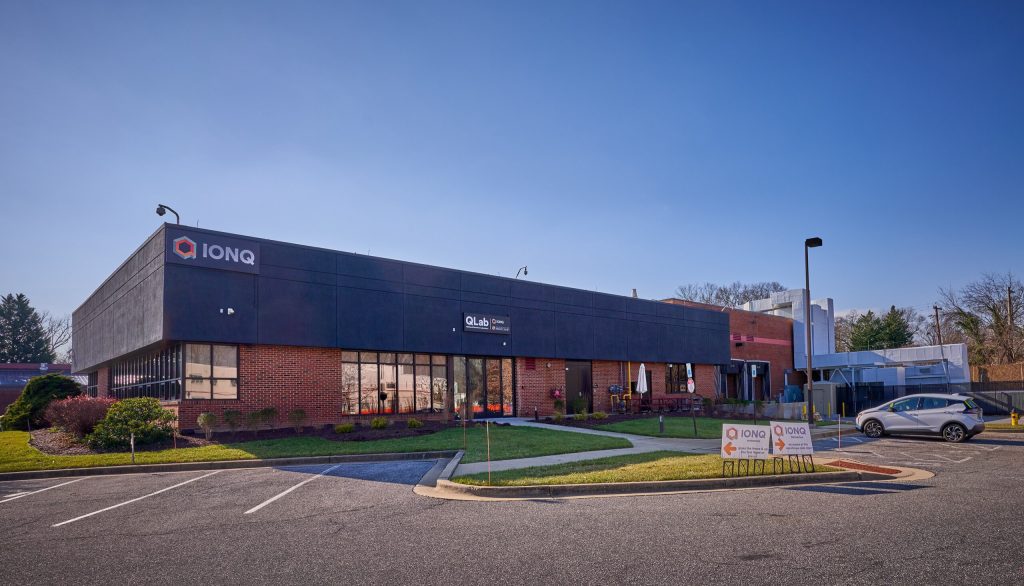
By Blacktupelo – Own work, CC BY-SA 4.0, https://commons.wikimedia.org/w/index.php?curid=142848633
From Lab Lights to a Startup Dream
There was once a lab that only lit up at night. At the far end of a University of Maryland hallway, under blue light, tiny ions stood in line inside a trap.
“Chris, look at that emission pattern,” said Jungsang Kim (co-founder, then Duke professor). Christopher Monroe (co-founder, then UMD professor) nodded.
“We should take this outside the lab. It works too well to remain just an experiment.”
In 2015, carrying 25 years of academic research, the two founded IonQ. Their seed funding—$2 million from NEA—set the goal clearly: turn trapped-ion quantum computing into a product.
Quantum Computing Meets the Cloud
At early investor meetings, one asked:
“Where does your product actually run? Are you just selling hardware?”
Monroe replied: “Both. Our machines will be accessible through the cloud.”
By 2021, IonQ systems were available on AWS Braket, Microsoft Azure, and Google Cloud. Hardware sat in one place, computation attached and detached as needed. Researchers could work on the same dataset without duplication.
“No lock-in. Multiple teams, same data, simultaneous processing—that’s our design philosophy,” said an engineer.
Going Public: A Pure-Play Quantum Company
On October 1, 2021, IonQ completed a SPAC merger with dMY Technology Group III and began trading on the NYSE as “IONQ.”
It was the first pure-play quantum computing company to go public. $636 million in cash became fuel for R&D, manufacturing, and business growth.
“We’ve just raised the bridge from science to industry,” read the message to staff that night.
From Experiments to Factories
The bridge soon led to a factory. In February 2024, IonQ opened a 100,000+ sq. ft. manufacturing facility in Bothell, Washington.
“Not lab equipment but products. Not hand-built demos but production lines.” The internal briefing line became reality on the shop floor.
The U.S. Senate Commerce Committee called it “America’s first dedicated quantum computer manufacturing plant.” Trapped-ion chips and optical modules flowed across assembly cells, with racks sent straight into cloud datacenters.
Breaking Performance Milestones
IonQ’s technology curve didn’t stop there. In January 2024, it announced achieving #AQ 35—its proprietary algorithmic qubit benchmark—a year earlier than planned.
“Algorithmic performance means factoring in depth, error rates, calibration,” explained a researcher.
This wasn’t just marketing—it was a signal that circuits of meaningful size could now solve real problems.
“Small steps now, but when accumulated, they shift industries,” Monroe said.
Forte Enterprise: Quantum as a Service
By spring 2025, IonQ’s catalog proudly listed Forte Enterprise.
“Available worldwide through Braket and IonQ Cloud.”
A sales call went like this:
“Our team works in Azure—does that matter?”
The architect smiled: “No worries. We built multi-cloud access from day one.”
The field language simplified: credits consumed computing, workloads flexibly drew quantum resources, and elasticity defined usage.
Expanding Through Acquisitions
IonQ didn’t stop at its own stack. In June 2025, it acquired Oxford Ionics, a U.K. startup from Oxford University, in a deal worth over $1B in stock and cash.
Though both used trapped-ion technology, Oxford Ionics specialized in ion-trap-on-a-chip integration and ultra-precise control.
Their roadmap—“hundreds of thousands of logical qubits, 2 million physical qubits by 2030”—sparked debate across the community.
Stocks jumped, and discussions heated up on the intersection of ion-trap physics and semiconductor fabrication.
Leadership and Governance Shifts
Leadership evolved too. Peter Chapman (CEO since 2019, formerly at Amazon Prime) stepped down from the board in 2025.
Niccolo de Masi, who had become CEO in February, also assumed the role of Chairman in August.
Meanwhile, co-founder Christopher Monroe took on a new role: Chief Scientific Advisor.
“We’re strengthening both science and management,” read the filing—calm words, but a clear signal.
Scaling Up: Numbers and Growth
The numbers told their own story. In Q2 2025, IonQ reported $20.7M in revenue, beating guidance by 15%. Losses widened due to R&D and acquisitions, but the company completed a $1B capital raise, bringing pro forma cash to $1.6B.
Banks disagreed: “Investing despite uncertainty” vs. “Limited visibility on commercialization.”
But one phrase stood out in bold letters on IonQ’s financials:
“We are riding the curve of scale.”
Partnerships and Real-World Validation
External lights shone too.
AstraZeneca reported a 20x speed-up in drug discovery workloads. Oak Ridge, AWS, and NVIDIA announced joint benchmarks with IonQ hardware.
“Hybrid quantum-classical computing is no longer just a paper—it’s a working diagram,” one engineer told a client.
“Bringing the model to the data, without moving the data—that’s what matters.”
IonQ Today: Between Lab and Industry
Today, IonQ carries both the memory of the lab and the smell of the factory.
Blue lasers trap ions, while fans hum in datacenter racks. Assembly cells in Bothell connect directly to Braket consoles, multi-cloud permissions, and the next acquisition announcement.
Across all these scenes runs a single thread:
“Bring the model and computation to the data.”
It’s the line IonQ repeats, and the way a small 2015 team imagines a vast 2030 system.
Epilogue: The Unfinished Story
Monroe once smiled and said,
“Science must be honest, and industry must be persistent.”
Kim replied,
“To do both, we’ll need a few more sleepless nights.”
The lab’s blue light flickered, then lit up again.
As long as that glow endures, this story isn’t finished.

By IonQ – https://ionq.com/, Public Domain, https://commons.wikimedia.org/w/index.php?curid=153130649
